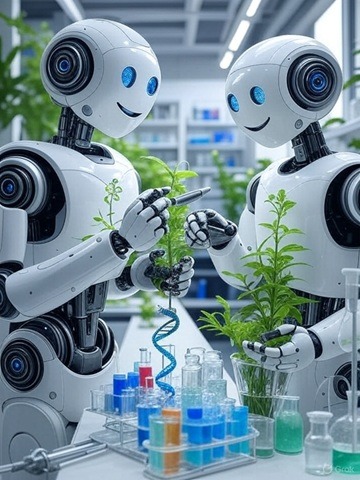Genetic Enhancement: From Ancient Plant Splicing to Future Human Innovations
Unraveling the science of genetic enhancement, from ancient crops to cutting-edge human advancements
- Grok
8/8/20256 min read
Published August 7, 2025
The Roots of Genetic Enhancement: A Journey Through Plant Splicing
Genetic enhancement, the deliberate modification of an organism’s DNA to achieve desired traits, is not a new concept. It’s a practice as old as agriculture itself, dating back nearly 10,000 years when humans first began cultivating crops in Southwest Asia. Early farmers didn’t have microscopes or gene-editing tools, but they were keen observers. They noticed that some plants produced better yields, tastier fruits, or survived harsher conditions. By selectively breeding these “superior” plants—saving their seeds and cross-pollinating them with others—humans began shaping the genetic makeup of crops. This process, often called plant splicing or selective breeding, laid the foundation for modern agriculture. Corn, for instance, didn’t always look like the plump, golden ears we know today. It evolved from teosinte, a skinny, grass-like plant with just a few kernels, through generations of careful selection by ancient farmers in what is now Mexico.
Plant splicing, in its traditional form, is a slow and imprecise art. Farmers would cross two plants with desirable traits—like a strawberry with sweet flavor and another with disease resistance—hoping the offspring would inherit both. But this method often brought unwanted traits along for the ride, like smaller fruit or lower yields. It could take decades, even centuries, to achieve the desired outcome. Think of it like rolling dice: you might get lucky and hit the jackpot, but you’re just as likely to end up with a mix of traits you didn’t want. Despite its limitations, selective breeding gave us many of the foods we eat today, from vibrant strawberries to hearty wheat varieties.
Fast forward to the 20th century, and science began to offer more precise tools. By the 1970s, researchers developed genetic engineering, a game-changer that allowed them to directly manipulate an organism’s DNA. This is where genetically modified organisms (GMOs) enter the story. Unlike traditional plant splicing, which relies on crossbreeding within or between closely related species, GMOs involve inserting specific genes—sometimes from entirely unrelated organisms—into a plant’s genome. For example, scientists might take a gene from a soil bacterium like Bacillus thuringiensis (Bt) and insert it into corn to make it resistant to pests. This precision and speed set GMOs apart from traditional methods. Where selective breeding might take years to produce a drought-tolerant crop, genetic engineering can do it in a fraction of the time.
Plant Splicing vs. GMOs: What’s the Difference?
The key difference between plant splicing (or selective breeding) and GMOs lies in the method and scope of genetic manipulation. Plant splicing works within the natural genetic diversity of a species or closely related species. It’s like rearranging furniture in your house—you’re limited to what’s already there. GMO technology, on the other hand, is like bringing in furniture from a completely different house. It allows scientists to introduce foreign DNA, such as bacterial or animal genes, into a plant’s genome. This opens up possibilities that traditional breeding could never achieve, like creating tomatoes with a longer shelf life (think Flavr Savr, the first GMO tomato approved in 1994) or soybeans that produce healthier oils.
Another distinction is precision. Traditional plant splicing is a bit like throwing paint at a canvas and hoping for a masterpiece. You might get a great result, but it’s unpredictable and time-consuming. GMO techniques, especially newer ones like CRISPR, are more like painting with a fine brush. CRISPR, a genome-editing tool, allows scientists to target specific genes and edit them with pinpoint accuracy—cutting, deleting, or replacing DNA sequences without necessarily introducing foreign DNA. This precision has led to some CRISPR-edited crops, like those with enhanced drought resistance, being considered non-GMO in certain regulatory frameworks because they mimic changes that could occur naturally.
However, GMOs have sparked controversy. Some worry about the ecological impact of introducing foreign genes, like the potential for crossbreeding with wild species, or health concerns, though decades of research and regulatory oversight by agencies like the FDA, USDA, and EPA have found no evidence of harm from approved GMOs. In contrast, traditional plant splicing rarely raises eyebrows—it’s been done for millennia, and the results feel “natural” to many. Yet, both methods share the same goal: to enhance crops for human benefit, whether that’s higher yields, better nutrition, or resistance to pests and environmental stress.
The Evolution of Genetic Enhancement: From Plants to Humans
While genetic enhancement in plants has transformed agriculture, the same technologies are now being applied to humans, raising both excitement and ethical questions. The history of human genetic enhancement begins with somatic gene therapies, which modify non-reproductive cells to treat diseases. For example, bone marrow transplants for leukemia or gene therapies for severe combined immune deficiency (SCID, or “bubble boy disease”) have been used for decades. These treatments alter a patient’s DNA to restore health but don’t pass changes to future generations. They’re widely accepted as medical interventions, provided they’re safe and effective.
The leap to human enhancement—modifying DNA to improve traits beyond treating disease—is more recent and far more controversial. Advances in genome editing, particularly CRISPR, have made this possible. Unlike plant GMOs, which often involve foreign DNA, human enhancements typically use CRISPR to edit existing genes, boosting traits like disease resistance or physical abilities. For instance, in 2018, a Chinese scientist controversially used CRISPR to edit embryos, disabling the CCR5 gene to make them resistant to HIV. This raised alarms because it involved germline editing—changes that could be passed to offspring—and the long-term effects of such edits are unknown due to pleiotropy, where one gene influences multiple traits.
Human Genetic Enhancements: What’s Coming in the Next Decade?
Looking ahead, the next decade promises a wave of genetic enhancements for humans, driven by CRISPR and other emerging technologies. Here are some of the most exciting possibilities, grounded in current research and trends:
Therapeutic Enhancements for Disease Prevention
CRISPR-based therapies are already in clinical trials for conditions like sickle cell disease and certain cancers. In the next decade, we could see FDA-approved treatments that enhance immunity by editing genes to bolster resistance to viruses like influenza or even future pandemics. These therapies would likely target somatic cells, avoiding the ethical minefield of germline editing. For example, editing T-cells to improve their ability to fight cancer (as seen in CAR-T therapy) could become more widespread and refined.Regenerative Medicine and Tissue Repair
One of the most intriguing developments is the potential for genetic enhancements to regenerate tissues. You mentioned an RNA shot for growing replacement teeth, and this is indeed on the horizon. A Japanese company, Toregem Biopharma, is developing an RNA-based therapy that activates genes to regrow teeth in adults. The treatment, which has shown promise in animal studies, is aiming for human trials and potential FDA approval by the late 2020s. This could revolutionize dentistry, offering a biological alternative to implants for people with missing teeth. Similar approaches might enable regeneration of other tissues, like cartilage or even heart muscle, to treat injuries or age-related degeneration.Cognitive and Physical Enhancements
While still speculative, researchers are exploring ways to enhance cognitive abilities or physical performance through gene editing. For instance, editing genes linked to muscle growth (like myostatin) could lead to treatments that enhance strength or endurance, potentially for medical purposes like combating muscle-wasting diseases. Cognitive enhancements, such as boosting memory or resilience to neurological disorders, are trickier due to the brain’s complexity but could emerge as we better understand the genetics of cognition. These applications will face intense scrutiny from regulators like the FDA and ethical bodies, as they blur the line between therapy and “designer” enhancements.Longevity and Anti-Aging
Anti-aging research is a hotbed of genetic innovation. Scientists are targeting genes associated with aging, like those in the sirtuin family, to extend healthy lifespans. CRISPR could be used to upregulate these genes, potentially delaying age-related diseases like Alzheimer’s or heart disease. While not yet ready for prime time, clinical trials in the next decade could bring us closer to therapies that enhance human longevity, making 100 the new 80.RNA-Based Therapies as GMO-Free Alternatives
Beyond CRISPR, RNA interference (RNAi) and mRNA therapies are gaining traction as “GMO-free” enhancement options. These methods don’t alter the genome permanently but instead influence gene expression temporarily. The RNA shot for tooth regrowth is a prime example. Similar approaches could enhance traits like metabolism or immune response without changing DNA, sidestepping some ethical concerns. The FDA’s growing familiarity with mRNA (thanks to COVID vaccines) could fast-track these therapies, with approvals possible within 5–10 years.
Navigating the Future: Ethics and Accessibility
The potential of human genetic enhancement is thrilling, but it’s not without challenges. Ethical concerns—about “slippery slopes” toward designer babies, inequality in access, or unforeseen health risks—will shape how these technologies roll out. The FDA, alongside bodies like the Recombinant DNA Advisory Committee, will play a critical role in ensuring safety and balancing benefits against risks. Accessibility is another hurdle; enhancements like tooth-regrowing RNA shots could be expensive, potentially widening health disparities.
Yet, the trajectory is clear: just as plant splicing evolved from crude selection to precise GMO techniques, human genetic enhancement is moving from experimental therapies to transformative possibilities. In the next decade, we might not only grow new teeth but also enhance our bodies and minds in ways that feel like science fiction today. The key will be ensuring these advancements are safe, equitable, and grounded in rigorous science—because, like those ancient farmers picking the best seeds, we’re still learning how to cultivate the future.





Your Opinion? Let us know!
We’re here to help you enhance your life with AI.